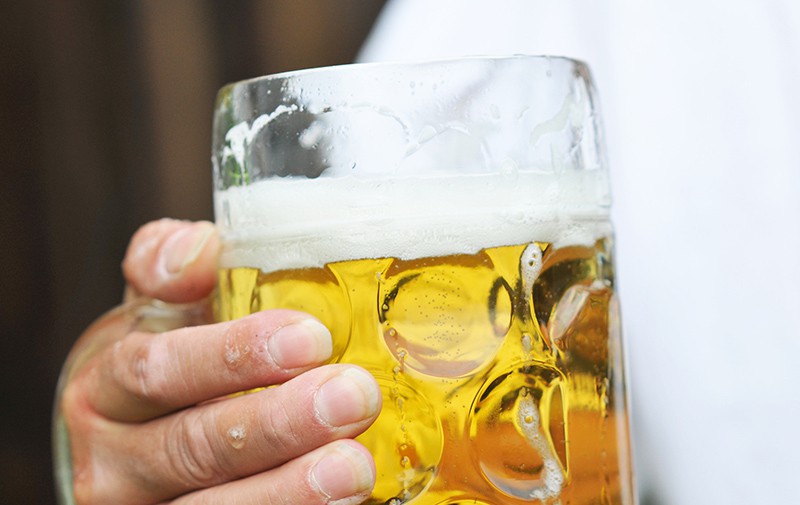
Like many farmstead cheesemakers, old-world brewers knew what it meant to be at the whim of Mother Nature and Earth’s rotation. Since brewing requires closely controlled temperatures, it’s no surprise that the warm summer months posed a challenge to brewers before the inception of refrigeration. In particular, those in fifteenth-century Bavaria noticed that their beer would remain more stable—not infected by warm-weather-loving bacteria—if fermented and aged in cold temperatures. What they didn’t know at the time was that the yeast in their beer was adapting and growing an affinity for those cold temperatures. That yeast would later be isolated and categorized as Saccharomyces uvarum—or lager yeast.
And so it became that the brewing cycle in early Germany began in the fall and ended with the spring. Beer would be brewed during those temperate months and stored in cold caves over the summer. Come fall, the beer remaining in those caves would emerge as something truly unique at the time: a reddish concoction with prominent sweetness and a bit more alcohol than imbibers were used to at the time.
It was nineteenth-century brewer Gabriel Sedlmayr who first created Märzen, which translates, appropriately, to “March beer.” Sedlmayr based his unique beer on an adaptation of the Vienna lager originally developed by his brewing predecessor Anton Dreher—an icon of ye olde brewing times. Sedlmayr brewed his Märzen, naturally, in March, waiting to tap into it until it was time for a little harvest festival we now call Oktoberfest. His patience was rewarded, as revelers went bonkers for this new, remarkably smooth style of beer.
Traditional Märzen, both then and now, exhibits a wonderful pop of toasty, bready malt characteristics. It’s full-bodied and rich with some caramel sweetness, typically dark copper in color, and it delivers a medium to high alcohol content. While drinkers shouldn’t expect to find much of a hop aroma, most classic recipes include a decent dosing of noble hops—grown in Germany and the Czech Republic—leaving some bitterness that helps cleanse the palate of all that malt sweetness. Most original versions exhibit an orange-to-red-to-copper hue, but some breweries create an Oktoberfest-style beer with a more golden color.
With the increasing popularity—or maybe that’s notoriety—of Munich’s Oktoberfest, beers bearing the festival’s name continue to pop up around the world. While formulas may change from brewery to brewery, the style is still referred to as Märzen, Oktoberfest, or even Festbier. Many American craft breweries have done quite well leaving the big West Coast hops in the cooler and instead giving a little attention to that wonderful Vienna malted barley. And it’s specifically that juicy malt profile that affords us some amazing cheese-pairing opportunities.
Much like the Märzen, Alpine-style cheeses have been historically crafted to suit the changing seasons. These Alpine-style cheeses may change slightly, depending on the altitude where the animals have been feeding, but in nearly all cases tasters will find a wonderful nuttiness that compliments the toasty, malty notes of the Märzen. In honor of this longstanding favorite, I’ve highlighted three pairings that showcase the Bavarian-style work of American artisan brewers and cheeses ideally suited to them.
Three Floyds Brewing Company Munster Fest and Meadow Creek Dairy Appalachian
Though Three Floyds Brewing Company is known for making beers that are atypical by everyday standards, its seasonal offering hits the stylistic mark dead-on. It pours a beautiful orangey color and emits a thin head of carbonation that fills the nostrils with bready sweetness, which carries over onto the palate initially. From there a grassy note of hops helps balance the beer through the finish.
This Bavarian artistry is matched nicely by a wedge of Meadow Creek Dairy’s Appalachian—an aptly named cheese created at an elevation of 2,800 feet. Truly a tomme-style cheese with a firm paste and earthy undertones, Appalachian plays nicely with the Munster Fest’s noble hop profile. The beer’s crisp finish is a welcome match to the cheese’s buttery notes as well.
(6% alcohol by volume)
Great Lakes Brewing Company Oktoberfest and Crawford Family Farm Vermont Ayr
In a nod to the fall celebrations that Cleveland’s German immigrants once held, Great Lakes Brewing Company crafts this traditional-style Märzen around harvest time every year. True to style, this eco-friendly operation utilizes Munich malt to provide a good body and toasty aroma; an American-grown version of the Hallertau hop variety—a quintessential German hop—lends a mild bitterness on the palate.
Vermont Ayr is an award-winning cheese made exclusively from the raw milk of the Crawford family’s Ayrshire cows—the high butterfat content gives the cheese its sweet notes. Three months of climate-controlled aging on the farm leaves the cheese with a nutty interior, suited ideally to the Oktoberfest’s elegant malt character. The rich sweetness of both cheese and beer meld together at the finish.
(6.5% alcohol by volume)
Victory Brewing Company Festbier and Thistle Hill Farm Tarentaise
Victory Brewing Company has garnered a reputation for taking an accurate approach to old-world styles, and its Festbier is a solid example. German pilsner, Munich, and Vienna malts provide aromas of toasted grain and hints of caramel on the palate. Whole-flower, German-grown hops add slightly spicy notes that play off the malt sweetness and finish clean and dry.
Tarentaise, from Thistle Hill Farm, may be one of the most accurate American artisan representations of the Alpine style. In fact, the Putnam family imported molds from France for this cheese to mimic the look of the European staples: 14 inches in diameter, four inches tall, and with concave sides. Careful aging and rind-washing give Tarentaise a complex blend of fruitiness, caramel nuttiness, and subtle earthy funk, all of which offer plenty of complementary and contrasting notes with Victory’s Festbier.
(5.6% alcohol by volume)







